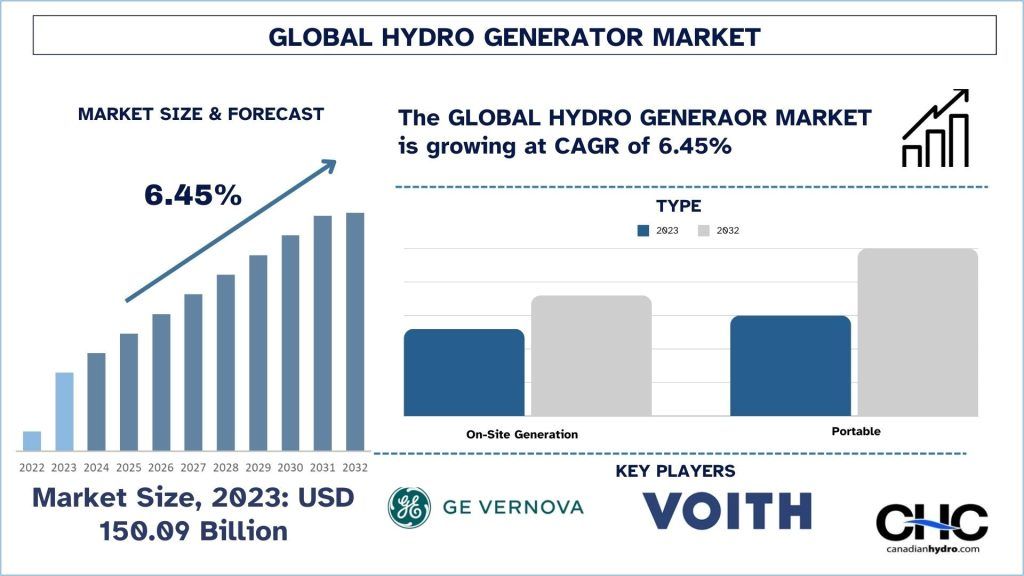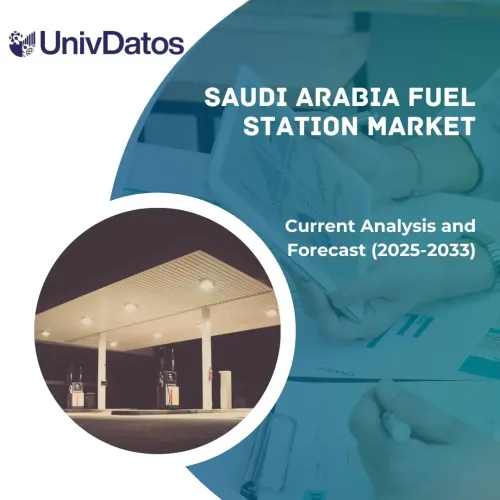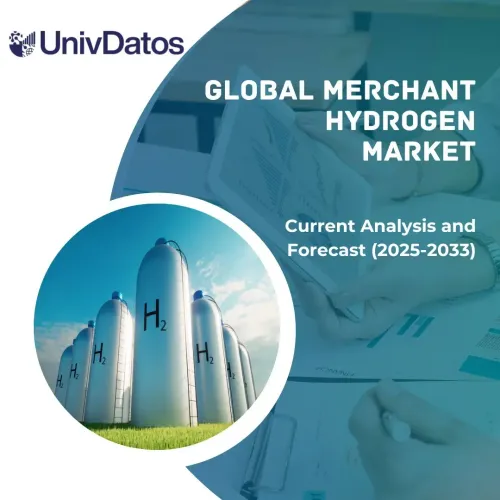- Startseite
- Über uns
- Industrie
- Dienstleistungen
- Lesen
- Kontaktieren Sie uns
Markt für Wasserkraftgeneratoren: Aktuelle Analyse und Prognose (2024-2032)
Schwerpunkt auf Typ (Vor-Ort-Erzeugung); Anwendung (Bis zu 100 KW, 101 bis 250 KW, 251 bis 500 KW, 501 bis 750 KW und 751 KW und darüber); und Region/Land
Hydro Generator Marktgröße & Prognose
Der Hydro Generator Markt wurde im Jahr 2023 auf 150,09 Milliarden USD geschätzt und wird voraussichtlich mit einer starken CAGR von rund 6,45 % während des Prognosezeitraums (2024-2032) wachsen. Hydrogeneratoren sind elektromechanische Geräte, die in Wasserkraftwerken verwendet werden, um die mechanische Energie von fließendem oder fallendem Wasser in elektrische Energie umzuwandeln. Sie bestehen typischerweise aus drei Hauptkomponenten: Turbinen, Generatoren und zugehörigen Steuerungssystemen. Turbinen werden durch die Kraft des fließenden Wassers angetrieben, das Wellen dreht, die mit Generatoren verbunden sind, die dann durch elektromagnetische Induktion Elektrizität erzeugen. Wasserkraft ist eine der ältesten und am weitesten verbreiteten Formen erneuerbarer Energie und macht etwa 16 % der weltweiten Stromerzeugung aus. Große Wasserkraftwerke, wie z. B. Staudämme und Stauseen, dominieren die globale Wasserkraftkapazität, während kleinere Anlagen wie Laufwasserkraftwerke und Mikro-Wasserkraftsysteme dezentrale und netzunabhängige Anwendungen bedienen.
Hydro Generator Marktanalyse
Die Erneuerung und Modernisierung bestehender Wasserkraftanlagen schaffen bedeutende Chancen innerhalb des Hydro Generator Marktes. Dieser Ansatz konzentriert sich auf die Modernisierung alternder Infrastruktur, um die Effizienz zu steigern, die Kapazität zu erhöhen und die Lebensdauer von Wasserkraftwerken zu verlängern. Durch den Einsatz fortschrittlicher Technologien und innovativer Lösungen können bestehende Anlagen revitalisiert werden, was zahlreiche Vorteile bietet, wie z. B. verbesserte Leistung, geringere Umweltbelastung und Kosteneinsparungen. Dieser Trend gewinnt weltweit an Bedeutung, da die Länder bestrebt sind, Ziele für erneuerbare Energien zu erreichen und eine nachhaltige Energieerzeugung sicherzustellen.
Ältere Anlagen arbeiten oft mit veralteter Technologie, was zu geringeren Wirkungsgraden und einer reduzierten Energieausbeute führt. Durch Modernisierungsmaßnahmen können alternde Turbinen, Generatoren und Steuerungssysteme durch modernste Geräte ersetzt werden, was die Leistung erheblich steigert. Zum Beispiel: Der La Grande Complex in Quebec, Kanada, veranschaulicht die Kosteneffizienz der Modernisierung bestehender Wasserkraftanlagen. Hydro-Québec, der Betreiber, führte ein umfangreiches Sanierungsprojekt durch, um mehrere Erzeugungseinheiten innerhalb des Komplexes zu modernisieren. Das Projekt umfasste den Austausch alter Turbinen durch effizientere Modelle und die Modernisierung der Steuerungssysteme.
Darüber hinaus bietet die Modernisierung bestehender Wasserkraftanlagen auch ökologische und soziale Vorteile. Durch die Verbesserung von Effizienz und Kapazität können modernisierte Anlagen mehr Strom erzeugen, ohne den Wasserverbrauch oder den ökologischen Fußabdruck zu erhöhen. Darüber hinaus kann die Integration fortschrittlicher Umwelttechnologien, wie z. B. fischfreundlicher Turbinen, die Auswirkungen auf aquatische Ökosysteme mildern.
Hydro Generator Markttrends
Entwicklung von Klein- und Mikro-Wasserkraft
Die Entwicklung von Klein- und Mikro-Wasserkraft ist ein bedeutender aktueller Trend auf dem Hydrogenerator-Markt, der durch den wachsenden Bedarf an nachhaltigen, dezentralen und kosteneffizienten Energielösungen angetrieben wird. Im Gegensatz zu großen Wasserkraftprojekten, die oft erhebliche ökologische und soziale Auswirkungen haben, bieten Klein- und Mikro-Wasserkraftsysteme eine flexiblere und umweltfreundlichere Alternative. Diese Systeme, die typischerweise als Anlagen mit einer Leistung von weniger als 10 MW für Kleinwasserkraft und weniger als 100 kW für Mikrowasserkraft definiert werden, gewinnen aufgrund ihrer zahlreichen Vorteile und der steigenden Nachfrage nach erneuerbarer Energie in abgelegenen und netzunabhängigen Gebieten an Bedeutung. Darüber hinaus eignen sich kleine und Mikro-Wasserkraftsysteme hervorragend für die dezentrale Energieerzeugung. Sie können abgelegene Gemeinden zuverlässig und kontinuierlich mit Strom versorgen, die Abhängigkeit von zentralen Netzen verringern und die Energiesicherheit erhöhen. In vielen Entwicklungsländern sind diese Systeme maßgeblich an der Bekämpfung der Energiearmut beteiligt.
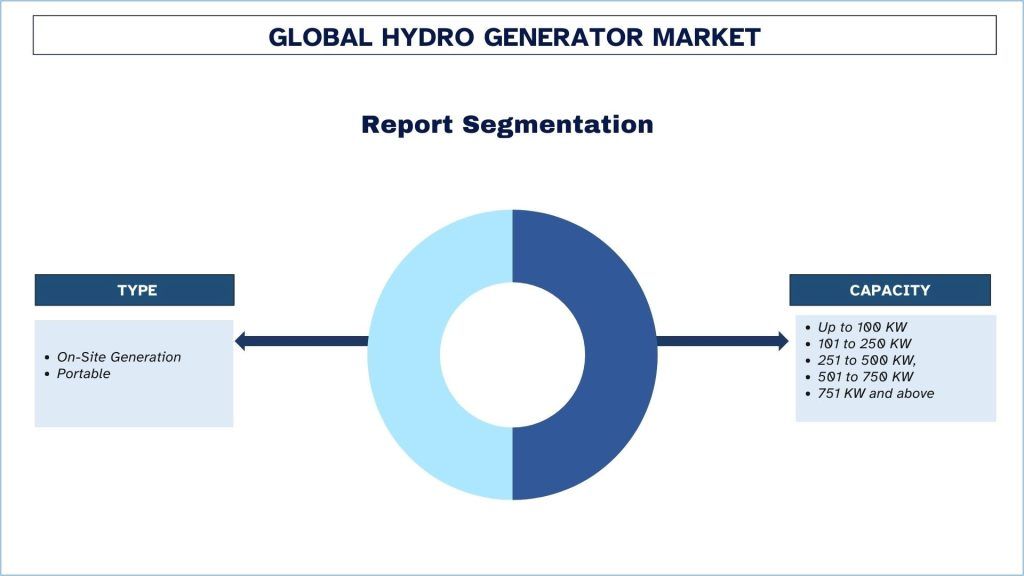
Es wird erwartet, dass Europa im Prognosezeitraum mit einer signifikanten CAGR wachsen wird
Der europäische Markt für Wasserkraftinfrastruktur spielt eine entscheidende Rolle in der Energielandschaft der Region. Aufgrund einer langen Tradition der Nutzung von Wasserkraft als erneuerbare Energiequelle haben viele europäische Länder erheblich in den Bau und die Instandhaltung von Wasserkraftinfrastruktur investiert. Dies hat es ihnen ermöglicht, ihre Abhängigkeit von fossilen Brennstoffen zu verringern und die Umweltauswirkungen ihrer Energieerzeugung zu mildern. Der Markt für Wasserkraftinfrastruktur in Europa umfasst ein breites Spektrum von Projekten, darunter große Wasserkraftstaudämme, Laufwasserkraftwerke und Pumpspeicherkraftwerke. Diese Projekte erzeugen nicht nur Strom, sondern bieten auch Vorteile wie Hochwasserschutz, Bewässerung und Wasserversorgung. Trotz der Bedeutung der Wasserkraftinfrastruktur in Europa steht der Markt vor mehreren Herausforderungen. Alternde Infrastruktur, sich verändernde regulatorische Rahmenbedingungen und zunehmender Wettbewerb durch andere erneuerbare Energiequellen sind einige der Faktoren, die das Wachstum der Branche beeinflussen.
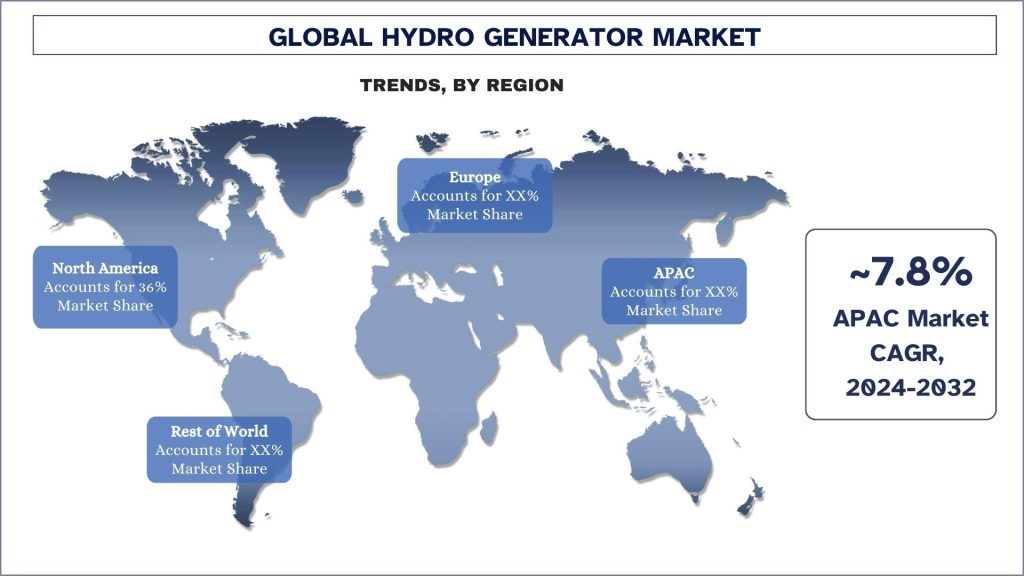
Hydro Generator Branchenüberblick
Der Hydro Generator Markt ist wettbewerbsintensiv und fragmentiert, mit der Präsenz mehrerer globaler und internationaler Marktteilnehmer. Die wichtigsten Akteure verfolgen verschiedene Wachstumsstrategien, um ihre Marktpräsenz zu verbessern, wie z. B. Partnerschaften, Vereinbarungen, Kooperationen, neue Produkteinführungen, geografische Expansionen sowie Fusionen und Übernahmen. Einige der wichtigsten Akteure auf dem Markt sind GE Vernova, Voith Hydro, Canadian Hydro Components, Canyon Hydro, Andritz, BHEL, Alstom, China Three Gorges Corporation, Zhejiang Jinlun Electromechanic Co., Ltd., Dongfang Electric.
Hydro Generator Markt News
Im Jahr 2023 erwarb Canyon Hydro James Leffel & Co., um das Produktangebot und die Marktreichweite von Canyon Hydro zu verbessern, insbesondere auf dem nordamerikanischen Markt. Es wird erwartet, dass der Zusammenschluss ein robusteres Portfolio an Wasserkraftlösungen schaffen wird, das von Leffels umfangreicher Erfahrung und Technologie in der Turbinenherstellung profitiert.
Im Jahr 2023 ging GE Vernova eine Partnerschaft mit Tacoma Power ein, um zwei 27 MW/33 MVA Turbinen- und Generatoranlagen im Wasserkraftwerk Cushman II in den USA zu erneuern.
Im Jahr 2022 ging CHC eine Partnerschaft mit mehreren kanadischen Versorgungsunternehmen ein, um kundenspezifische Turbinenkomponenten bereitzustellen und bestehende Systeme zu modernisieren, wodurch die Effizienz und Kapazität erhöht werden.
Hydro Generator Marktbericht Abdeckung
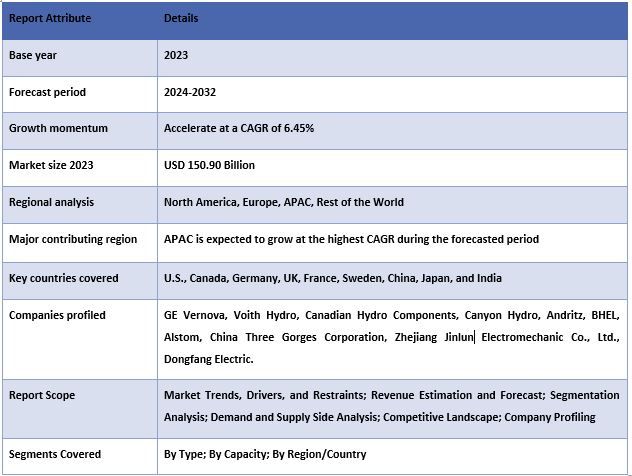
Gründe für den Kauf dieses Berichts:
- Die Studie beinhaltet eine Marktdimensionierungs- und Prognoseanalyse, die von authentifizierten Branchenexperten validiert wurde.
- Der Bericht bietet einen schnellen Überblick über die Gesamtleistung der Branche auf einen Blick.
- Der Bericht umfasst eine eingehende Analyse prominenter Branchenkollegen mit einem primären Fokus auf wichtige Geschäftskennzahlen, Produktportfolios, Expansionsstrategien und aktuelle Entwicklungen.
- Detaillierte Untersuchung von Treibern, Beschränkungen, wichtigen Trends und Chancen, die in der Branche vorherrschen.
- Die Studie deckt den Markt umfassend über verschiedene Segmente hinweg ab.
- Tiefgreifende regionale Analyse der Branche.
Anpassungsoptionen:
Der globale Hydro Generator Markt kann je nach Anforderung oder einem anderen Marktsegment weiter angepasst werden. Darüber hinaus versteht UMI, dass Sie möglicherweise Ihre eigenen geschäftlichen Anforderungen haben. Zögern Sie daher nicht, sich mit uns in Verbindung zu setzen, um einen Bericht zu erhalten, der Ihren Anforderungen vollständig entspricht.
Inhaltsverzeichnis
Forschungsmethodik für die Marktanalyse für Wasserkraftgeneratoren (2024-2032)
Die Analyse des historischen Marktes, die Schätzung des aktuellen Marktes und die Prognose des zukünftigen Marktes des globalen Marktes für Wasserkraftgeneratoren waren die drei wichtigsten Schritte, die unternommen wurden, um die Einführung von Wasserkraftgeneratoren in wichtigen Regionen weltweit zu erstellen und zu analysieren. Es wurden umfassende Sekundärrecherchen durchgeführt, um die historischen Marktzahlen zu erfassen und die aktuelle Marktgröße zu schätzen. Zweitens wurden zahlreiche Erkenntnisse und Annahmen berücksichtigt, um diese Erkenntnisse zu validieren. Darüber hinaus wurden umfassende Primärinterviews mit Branchenexperten entlang der Wertschöpfungskette des globalen Marktes für Wasserkraftgeneratoren geführt. Nach der Annahme und Validierung der Marktzahlen durch Primärinterviews wandten wir einen Top-Down-/Bottom-Up-Ansatz an, um die vollständige Marktgröße zu prognostizieren. Danach wurden Methoden der Marktaufschlüsselung und Datentriangulation angewendet, um die Marktgröße von Segmenten und Subsegmenten der betreffenden Branche zu schätzen und zu analysieren. Die detaillierte Methodik wird nachfolgend erläutert:
Analyse der historischen Marktgröße
Schritt 1: Eingehende Untersuchung von Sekundärquellen:
Es wurde eine detaillierte Sekundärstudie durchgeführt, um die historische Marktgröße des Marktes für Wasserkraftgeneratoren aus unternehmensinternen Quellen wie Jahresberichten und Finanzberichten, Performance-Präsentationen, Pressemitteilungen usw. sowie aus externen Quellen wie Fachzeitschriften, Nachrichten und Artikeln, Regierungsveröffentlichungen, Wettbewerbsveröffentlichungen, Branchenberichten, Datenbanken von Drittanbietern und anderen glaubwürdigen Veröffentlichungen zu erhalten.
Schritt 2: Marktsegmentierung:
Nachdem wir die historische Marktgröße des Marktes für Wasserkraftgeneratoren ermittelt hatten, führten wir eine detaillierte Sekundäranalyse durch, um historische Markteinblicke und Anteile für verschiedene Segmente und Subsegmente in wichtigen Regionen zu gewinnen. Die wichtigsten im Bericht enthaltenen Segmente sind Typ und Kapazität. Darüber hinaus wurden Länderanalysen durchgeführt, um die allgemeine Akzeptanz von Testmodellen in dieser Region zu bewerten.
Schritt 3: Faktorenanalyse:
Nachdem wir die historische Marktgröße verschiedener Segmente und Subsegmente erfasst hatten, führten wir eine detaillierte Faktorenanalyse durch, um die aktuelle Marktgröße des Marktes für Wasserkraftgeneratoren zu schätzen. Darüber hinaus führten wir eine Faktorenanalyse unter Verwendung abhängiger und unabhängiger Variablen wie Typ und Kapazität des Marktes für Wasserkraftgeneratoren durch. Es wurde eine gründliche Analyse der Angebots- und Nachfrageszenarien unter Berücksichtigung der Top-Partnerschaften, Fusionen und Übernahmen, der Geschäftsausweitung und der Produkteinführungen im Bereich des Marktes für Wasserkraftgeneratoren weltweit durchgeführt.
Aktuelle Marktgröße Schätzung und Prognose
Aktuelle Marktgrößenbestimmung: Basierend auf den umsetzbaren Erkenntnissen aus den oben genannten 3 Schritten haben wir die aktuelle Marktgröße, die wichtigsten Akteure auf dem globalen Markt für Wasserkraftgeneratoren und die Marktanteile der Segmente ermittelt. Alle erforderlichen prozentualen Anteile und Marktaufschlüsselungen wurden unter Verwendung des oben genannten sekundären Ansatzes ermittelt und durch Primärinterviews verifiziert.
Schätzung und Prognose: Für die Marktschätzung und -prognose wurden den einzelnen Faktoren, einschließlich der Triebkräfte und Trends, der Einschränkungen und der den Stakeholdern zur Verfügung stehenden Möglichkeiten, Gewichte zugewiesen. Nach der Analyse dieser Faktoren wurden relevante Prognosetechniken, d. h. der Top-Down-/Bottom-Up-Ansatz, angewendet, um die Marktprognose für 2032 für verschiedene Segmente und Subsegmente in den wichtigsten Märkten weltweit zu erstellen. Die zur Schätzung der Marktgröße angewandte Forschungsmethodik umfasst:
- Die Marktgröße der Branche in Bezug auf den Umsatz (USD) und die Akzeptanzrate des Marktes für Wasserkraftgeneratoren in den wichtigsten Märkten im Inland
- Alle prozentualen Anteile, Aufteilungen und Aufschlüsselungen von Marktsegmenten und Subsegmenten
- Wichtige Akteure auf dem globalen Markt für Wasserkraftgeneratoren in Bezug auf die angebotenen Produkte. Außerdem die Wachstumsstrategien, die diese Akteure anwenden, um in dem schnell wachsenden Markt zu konkurrieren.
Validierung der Marktgröße und des Marktanteils
Primärforschung: Es wurden eingehende Interviews mit den wichtigsten Meinungsführern (Key Opinion Leaders, KOLs) geführt, darunter Führungskräfte der obersten Ebene (CXO/VPs, Vertriebsleiter, Marketingleiter, Betriebsleiter, Regionalleiter, Länderchef usw.) in allen wichtigen Regionen. Die Ergebnisse der Primärforschung wurden dann zusammengefasst und eine statistische Analyse durchgeführt, um die aufgestellte Hypothese zu beweisen. Die Erkenntnisse aus der Primärforschung wurden mit den sekundären Erkenntnissen zusammengeführt, wodurch Informationen in umsetzbare Erkenntnisse umgewandelt wurden.
Aufteilung der primären Teilnehmer in verschiedenen Regionen
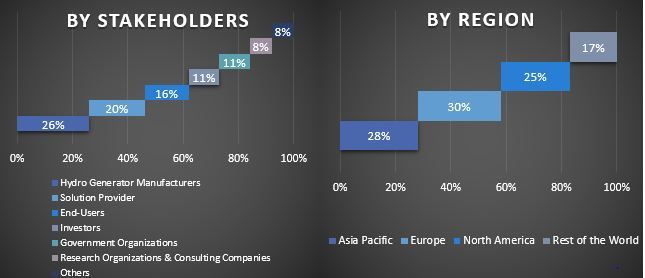
Market Engineering
Die Datentriangulationstechnik wurde eingesetzt, um die Gesamtmarktschätzung abzuschließen und präzise statistische Zahlen für jedes Segment und Subsegment des globalen Marktes für Wasserkraftgeneratoren zu erhalten. Die Daten wurden in verschiedene Segmente und Subsegmente aufgeteilt, nachdem verschiedene Parameter und Trends in den Bereichen Typ und Kapazität auf dem globalen Markt für Wasserkraftgeneratoren untersucht worden waren.
Das Hauptziel der globalen Marktstudie für Wasserkraftgeneratoren
Die aktuellen und zukünftigen Markttrends des globalen Marktes für Wasserkraftgeneratoren wurden in der Studie genau bestimmt. Investoren können strategische Einblicke gewinnen, um ihre Entscheidungen für Investitionen auf der Grundlage der in der Studie durchgeführten qualitativen und quantitativen Analyse zu treffen. Die aktuellen und zukünftigen Markttrends bestimmten die Gesamtattraktivität des Marktes auf regionaler Ebene und boten den Industrieteilnehmern eine Plattform, um den unerschlossenen Markt zu nutzen und von einem First-Mover-Vorteil zu profitieren. Weitere quantitative Ziele der Studien sind:
- Analyse der aktuellen und prognostizierten Marktgröße des Marktes für Wasserkraftgeneratoren in Bezug auf den Wert (USD). Analysieren Sie auch die aktuelle und prognostizierte Marktgröße verschiedener Segmente und Subsegmente.
- Zu den Segmenten in der Studie gehören die Bereiche Typ und Kapazität.
- Definition und Analyse des regulatorischen Rahmens für den Wasserkraftgenerator
- Analyse der Wertschöpfungskette mit der Präsenz verschiedener Vermittler sowie Analyse des Kunden- und Wettbewerberverhaltens der Branche.
- Analyse der aktuellen und prognostizierten Marktgröße des Marktes für Wasserkraftgeneratoren für die wichtigsten Regionen.
- Zu den wichtigsten Ländern der im Bericht untersuchten Regionen gehören der asiatisch-pazifische Raum, Europa, Nordamerika und der Rest der Welt.
- Unternehmensprofile des Marktes für Wasserkraftgeneratoren und die von den Marktteilnehmern angewandten Wachstumsstrategien, um sich in dem schnell wachsenden Markt zu behaupten.
- Detaillierte regionale Analyse der Branche
Häufig gestellte Fragen FAQs
F1: Wie groß ist die aktuelle Marktgröße und das Wachstumspotenzial des Wasserkraftgeneratormarktes?
F2: Was sind die treibenden Faktoren für das Wachstum des Wasserkraftgenerator-Marktes?
F3: Welches Segment hat den größten Anteil am Markt für Wasserkraftgeneratoren nach Typ?
F4: Welche aufkommenden Technologien und Trends gibt es auf dem Markt für Wasserkraftgeneratoren?
F5: Welche Region wird den Wasserkraftgenerator-Markt dominieren?
Verwandt Berichte
Kunden, die diesen Artikel gekauft haben, kauften auch

